
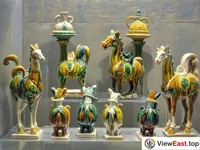
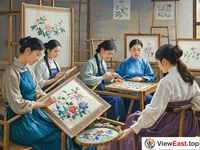
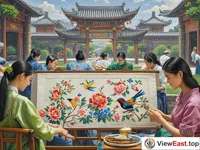
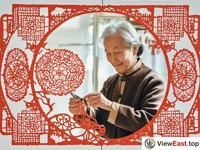
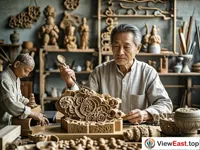

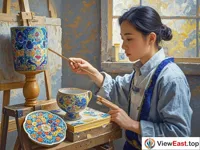
Introduction
China's traditional handicrafts are an essential part of the Chinese national culture, carrying a wealth of historical information and unique artistic styles. Each handicraft is a testament to the spirit of the craftsmen and a crystallization of wisdom and skill. These intangible cultural heritages are not only witnesses to history but also vital carriers of cultural heritage.
Ceramic Art
China's ceramic art has a long history, from Tang Sancai to blue and white porcelain, each piece showcases the exquisite skills of the artisans.
Jingdezhen Ceramics
Known as the "Porcelain Capital," Jingdezhen's ceramics are renowned for their "whiteness like jade, clarity like a mirror, thinness like paper, and sound like a chime." The ceramic craft of Jingdezhen has been passed down through generations, forming a unique porcelain-making culture.
Tang Sancai
Tang Sancai represents the ceramic art of the Tang Dynasty, famous for its rich colors and vivid shapes. They are not only practical items but also artworks, reflecting the prosperity and openness of the Tang era.
Embroidery Craft
Chinese embroidery is known for its exquisite stitching and delicate patterns. Suzhou embroidery, Guangdong embroidery, Sichuan embroidery, and Hunan embroidery are collectively known as the four famous embroideries of China.
Suzhou Embroidery
Suzhou embroidery is characterized by its fineness and elegance, often depicting animals like cats and tigers with lifelike effects.
Sichuan Embroidery
Sichuan embroidery is famous for its bright colors and varied stitching techniques, commonly used to portray natural scenes such as flowers, birds, fish, and insects.
Paper Cutting Art
Paper cutting is one of the traditional Chinese folk handicrafts, creating various patterns through cutting or carving with scissors or knives.
Festival Paper Cuttings
During traditional festivals like the Spring Festival, paper cuttings are used to decorate doors and windows, expressing people's wishes for a better life and reverence for nature.
Wood Carving Craft
China's wood carving craft has a long history, known for its exquisite skills and diverse themes.
Dongyang Wood Carving
Dongyang wood carving is famous for its fine carving and vivid expression, often used for architectural decoration and furniture making.
Protection of Intangible Cultural Heritage
With the acceleration of modernization, traditional handicrafts face challenges in inheritance. The Chinese government and all sectors of society are working to protect these intangible cultural heritages.
Inheritance and Innovation
While protecting, it is also necessary to innovate traditional handicrafts to make them more in line with modern aesthetics and practical needs.
Conclusion
China's traditional handicrafts are treasures of the national culture, showcasing not only the spirit and skills of the craftsmen but also reflecting the life philosophy and aesthetic tastes of the Chinese nation. Gaining a deep understanding of these handicrafts allows us not only to better understand Chinese culture but also to find the integration of tradition and modernity in modern society.
Exploring China's traditional handicrafts, we can learn how to draw inspiration from ancient skills; studying intangible cultural heritage, we can learn how to inherit and promote the excellent traditions of the nation in modern life. The essence of these handicrafts is not only the inheritance of skills but also the transmission of culture.